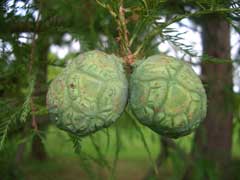 |
|
J.S. Peterson @ USDA-NRCS PLANTS Database |
 |
| http://de.wikipedia.org/wiki/Benutzer:Hanson59 |
Translate this page:
Summary
Bloom Color: Brown. Main Bloom Time: Early spring, Late spring, Mid spring. Form: Pyramidal, Upright or erect.
Physical Characteristics

 Taxodium_distichum is a deciduous Tree growing to 30 m (98ft) by 8 m (26ft) at a fast rate.
Taxodium_distichum is a deciduous Tree growing to 30 m (98ft) by 8 m (26ft) at a fast rate.
See above for USDA hardiness. It is hardy to UK zone 6. It is in flower in April, and the seeds ripen in October. The species is monoecious (individual flowers are either male or female, but both sexes can be found on the same plant) and is pollinated by Wind.
Suitable for: light (sandy), medium (loamy) and heavy (clay) soils. Suitable pH: mildly acid, neutral and basic (mildly alkaline) soils and can grow in very alkaline and saline soils.
It can grow in semi-shade (light woodland) or no shade. It prefers moist or wet soil and can grow in water. It can tolerate atmospheric pollution.
UK Hardiness Map
US Hardiness Map
Synonyms
Cupressus disticha.
Plant Habitats
Edible Uses
References More on Edible Uses
Medicinal Uses
Plants For A Future can not take any responsibility for any adverse effects from the use of plants. Always seek advice from a professional before using a plant medicinally.
The resin in the cones is used as an analgesic for wounds[149, 227].
References More on Medicinal Uses
The Bookshop: Edible Plant Books
Our Latest books on Perennial Plants For Food Forests and Permaculture Gardens in paperback or digital formats.

Edible Tropical Plants
Food Forest Plants for Hotter Conditions: 250+ Plants For Tropical Food Forests & Permaculture Gardens.
More

Edible Temperate Plants
Plants for Your Food Forest: 500 Plants for Temperate Food Forests & Permaculture Gardens.
More

More Books
PFAF have eight books available in paperback and digital formats. Browse the shop for more information.
Shop Now
Other Uses
The bark has been used to make cordage[257]. Wood - light, soft, not strong, moderately hard, easily worked, straight grained, very durable in damp soil, takes a good polish. It weighs 28lb per cubic foot[227]. The wood is not given to excessive warping or shrinking[227], it is used for construction, water pipes, vats etc[1, 46, 61, 82, 149, 171, 227].
Special Uses
References More on Other Uses
Cultivation details
Landscape Uses:Firewood, Pest tolerant, Massing, Screen, Specimen, Street tree. Although this plant can be grown in wet soils and shallow water, it thrives in any soil and trees actually grow faster in normal unflooded soils[81]. Established plants succeed in standing water up to 60cm deep[200] - in such a situation the roots develop 'knees', curious cone-shaped structures that grow above the ground[227]. Tolerates the high pH of chalk streams[200]. Tolerates atmospheric pollution[200]. Fairly cold-tolerant, but branches can be damaged by temperatures below -10°c[200]. A fairly vigorous tree, it can grow up to 45cm in a year with up to 4cm increase in girth[185]. It has been planted for its timber in S. Europe, especially on alluvial soils[50]. Buds often begin to break in March, but trees do not come properly into leaf until June and growth in height rarely starts before June[185]. A very healthy species in Britain, rarely seen in anything but good health. It seems to be a very long-lived tree in this country with several specimens more than 250 years old[185]. Trees are thought to live for over 1,000 years in the wild[227]. Plants grow best in areas with warm summers[200]. They only produce fertile seeds after long hot summers[200]. The branches are brittle and subject to wind damage, but the tree usually recovers well[81]. Unlike most conifers, this species responds well to coppicing[81]. Special Features:North American native, Wetlands plant, Attracts butterflies, Inconspicuous flowers or blooms.
References Carbon Farming Information and Carbon Sequestration Information
Temperature Converter
Type a value in the Celsius field to convert the value to Fahrenheit:
Fahrenheit:
The PFAF Bookshop
Plants For A Future have a number of books available in paperback and digital form. Book titles include Edible Plants, Edible Perennials, Edible Trees,Edible Shrubs, Woodland Gardening, and Temperate Food Forest Plants. Our new book is Food Forest Plants For Hotter Conditions (Tropical and Sub-Tropical).
Shop Now
Plant Propagation
Seed - sow late winter in a cold frame. When they are large enough to handle, prick the seedlings out into individual pots and grow them on in the greenhouse for at least their first winter. Plant them out into their permanent positions in late spring or early summer, after the last expected frosts. If sowing a lot of seed you could sow it in early spring in an outdoor seedbed[78]. Allow the plants to grow on in the seedbed for two years and then plant them into their permanent positions in late autumn or early spring. Cuttings in the late summer.
Other Names
If available other names are mentioned here
Native Range
NORTHERN AMERICA: United States (Indiana, Illinois, Missouri, Oklahoma, Alabama, Arkansas, Delaware, Florida, Georgia, Kentucky, Louisiana, Maryland, North Carolina, South Carolina, Virginia, Mississippi, Tennessee, Texas).
Weed Potential
Right plant wrong place. We are currently updating this section.
Please note that a plant may be invasive in one area but may not in your area so it’s worth checking.
Conservation Status
IUCN Red List of Threatened Plants Status :

Growth: S = slow M = medium F = fast. Soil: L = light (sandy) M = medium H = heavy (clay). pH: A = acid N = neutral B = basic (alkaline). Shade: F = full shade S = semi-shade N = no shade. Moisture: D = dry M = Moist We = wet Wa = water.
Expert comment
Author
(L.)Rich.
Botanical References
1143200
Links / References
For a list of references used on this page please go here
Readers comment
© 2010, Plants For A Future. Plants For A Future is a charitable company limited by guarantee, registered in England and Wales. Charity No. 1057719, Company No. 3204567.